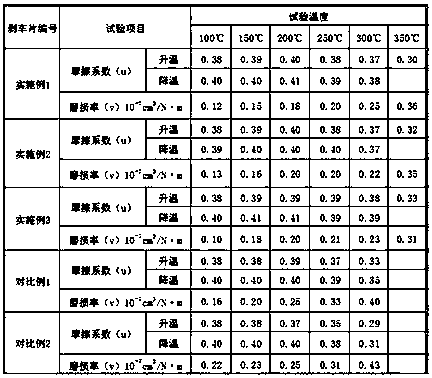Brake pad with multi-layer composite structure
A multi-layer composite, brake pad technology, applied in the field of auto parts, can solve the problems of easy brittleness of corners, high wear resistance, poor thermal conductivity, etc., and achieve the effects of sensitive braking, long service life and good wear resistance.
- Summary
- Abstract
- Description
- Claims
- Application Information
AI Technical Summary
Problems solved by technology
Method used
Image
Examples
specific Embodiment 1
[0012] Such as figure 1 As shown, the brake pad of the multilayer composite structure includes a steel back 3 and a brake pad body, the brake pad body is composed of an adhesive heat insulating layer 2 and a friction layer 1, and the adhesive heat insulating layer is composed of the following parts by weight The composition ratio is made: 5 parts of PROMAXON®D calcium silicate (1000 grams each, the same below), 6 parts of boron phenolic resin, 2 parts of magnesium oxide, 0.2 parts of nano-zinc oxide, 2 parts of nano-alumina, 0.2 parts of iso Propanol, 0.5 parts of zircon powder, 0.2 parts of sodium lauryl sulfate, 5 parts of polyacrylonitrile preoxidized fiber, 3 parts of nitrile rubber;
[0013] 19 parts of Lapinus-Roxul® 1000 engineering fiber, 9 parts of aramid fiber, 7 parts of polyacrylonitrile pre-oxidized fiber, 2 parts of alkali-free expanded glass fiber, 7 parts of graphite fiber, 15 parts of calcium sulfate whisker, 16 parts of titanic acid Potassium whisker, 1 part...
specific Embodiment 2
[0015] Specific embodiment two: as figure 1 As shown, the brake pad of the multilayer composite structure includes a steel back 3 and a brake pad body, the brake pad body is composed of an adhesive heat insulating layer 2 and a friction layer 1, and the adhesive heat insulating layer is composed of the following parts by weight Prepared by component ratio: 7 parts of PROMAXON®D calcium silicate, 4 parts of boron phenolic resin, 1 part of magnesium oxide, 0.1 part of nano-zinc oxide, 1 part of nano-alumina, 0.3 parts of isopropanol, 0.8 parts of zircon powder, 0.8 parts of sodium lauryl sulfate, 3 parts of polyacrylonitrile preoxidized fiber, 2 parts of nitrile rubber;
[0016] The friction layer is made of the following components by weight:
[0017] 15 parts of Lapinus-Roxul® 1000 engineering fiber, 7 parts of aramid fiber, 6 parts of polyacrylonitrile pre-oxidized fiber, 4 parts of alkali-free expanded glass fiber, 5 parts of graphite fiber, 17 parts of calcium sulfate whis...
specific Embodiment 3
[0019] Specific embodiment three: as figure 1 As shown, the brake pad of the multilayer composite structure includes a steel back 3 and a brake pad body, the brake pad body is composed of an adhesive heat insulating layer 2 and a friction layer 1, and the adhesive heat insulating layer is composed of the following parts by weight Prepared by component ratio: 6 parts of PROMAXON®D calcium silicate, 5.5 parts of boron phenolic resin, 1.3 parts of magnesium oxide, 0.1 part of nano-zinc oxide, 1.5 parts of nano-alumina, 0.25 parts of isopropanol, 0.7 parts of zircon powder, 0.5 parts of sodium lauryl sulfate, 4 parts of polyacrylonitrile preoxidized fiber, 2.8 parts of nitrile rubber;
[0020] The friction layer is made of the following components by weight:
[0021] 17 parts of Lapinus-Roxul® 1000 engineering fiber, 8 parts of aramid fiber, 6.5 parts of polyacrylonitrile pre-oxidized fiber, 3 parts of alkali-free expanded glass fiber, 6 parts of graphite fiber, 16 parts of calci...
PUM
 Login to View More
Login to View More Abstract
Description
Claims
Application Information
 Login to View More
Login to View More - R&D
- Intellectual Property
- Life Sciences
- Materials
- Tech Scout
- Unparalleled Data Quality
- Higher Quality Content
- 60% Fewer Hallucinations
Browse by: Latest US Patents, China's latest patents, Technical Efficacy Thesaurus, Application Domain, Technology Topic, Popular Technical Reports.
© 2025 PatSnap. All rights reserved.Legal|Privacy policy|Modern Slavery Act Transparency Statement|Sitemap|About US| Contact US: help@patsnap.com


